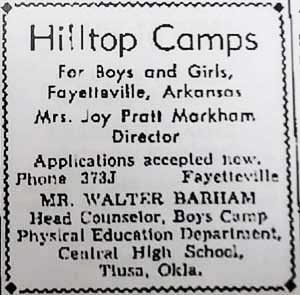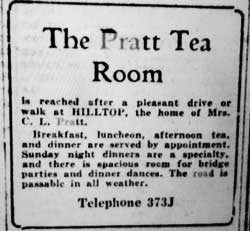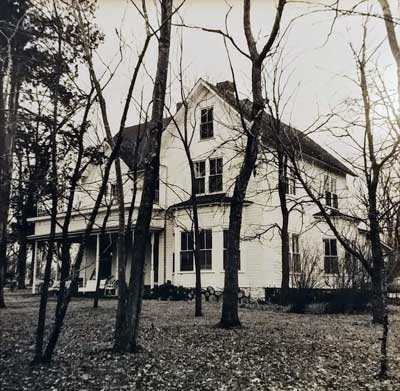Markham Hill Moment of History
2019-11-11
Joy Pratt Markham: Living at Pratt Place
Extracted from Pratt descendant’s writings.
|
Community Radio show aired on KPSQ 97.3 FM: |
Since Joy Pratt Markham’s father, Cassius L Pratt, had put all his capital into the Salina, Oklahoma project in 1906 for his four sons and that project failed, the family on Pratt Hill (later called Markham Hill) now had few resources. Their family home, Pratt Place, had to double as a rooming house by the end of the 1910s. There still were enough family resources to send both daughters, Joy and Evangeline, to the University of Arkansas. After Joy graduated, she studied at the Art Institute in Chicago from 1915-20 and again in the spring of 1921. Shortly after her marriage to Hogan Markham, the two returned to Fayetteville where they found a new use for Pratt Place and the 40-acre tract on which it sat. It became a coed summer camp and it opened its first season in 1921. Permanent camp buildings and facilities were built including a dining hall, recreation hall, ten camp cabins, and a huge spring-fed swimming pool. To provide themselves with a year-round income, Hogan and Joy went to Phoenix, Arizona, and created the Phoenix Country Day School which operated from September through May each year. It offered private education from kindergarten through high school.

Hilltop Camps newspaper ad
After World War II, Joy began offering horseback riding lessons using the extensive network of trails on the hill (which covered the original 40 acres as well as the additional acreage purchased by her sister). There were eight horses and every Saturday two or three one-hour riding sessions. Many of Fayetteville’s teenagers learned to ride through these lessons. The riding lessons drew in some University of Arkansas students as well and they formed a riding club called Boots and Spurs. Perhaps the inspiration for this was Joy’s son Gay who enrolled in the University in 1945 just after graduating from Fayetteville High School. He was a fine horseman, and strikingly handsome, which may account for the number of coeds who joined the club. The University riding group was helped by the fact that the University had a physical education requirement at the time and horseback riding counted as fulfilling that requirement.

Horseback riding "taught correctly."

In the mid-1950s Joy’s financial situation underwent a dramatic reversal. Sometime during the years that she and Hogan ran the Phoenix Day School, Joy purchased a beautiful plot of desert land on the side of Camelback Mountain. By the 1950s this was prize real estate and dozens of developers were interested in buying the land. They would drive to Fayetteville, take Joy out to dine, take her to church, sweet-talk everyone, and then be set aside in favor of another prospect. For several years this courtship went on until finally Joy did sell, resulting in the significant bequest she eventually left to the University of Arkansas in her will. It also provided her with the money to buy a nice car – a Rolls-Royce Silver Cloud. This car and Joy at the wheel became the talk of Fayetteville. The Rolls was parked under the pole shed west of Pratt Place or in the bay of the Carriage House once used for the Pratt buggy. Certain lucky young men had the privilege of driving for Joy and Mrs. Pratt in the Rolls to Tulsa and elsewhere.
Though financially secure, Joy continued to conduct trail rides, rented out all of the old camp cabins, occasionally rented rooms in Pratt Place, and happily sold to the City of Fayetteville the site where the water tower now sits because she would be able to get free water and a garden site within the confines of the water tower fence. The bathing facilities continued to be ones run off the well pump even after City water arrived. In the 1950s natural gas heaters were put in the bedrooms and parlors. The Pratt brothers purchased window air conditioners but neither Joy nor Mrs. Pratt liked them, so they were returned to the store.
As long a Mrs. Pratt was alive numerous nineteenth century practices continued at Pratt Place. She cooked on a wood stove and even replaced a fine cast iron wood stove for a new white enameled one. Cream from the upper fourth of the University of Arkansas’ dairy’s clear glass quart milk bottles was hand-churned into butter and then packed into wooden molds with a floral design on top. Bacon grease was saved, mixed with lye, turned into soap in baking pans, and then cut into 2 by 2-inch blocks. Bread dough was kneaded on the zinc-covered kitchen tabletop and after rising was baked in the wood stove. Dishes were washed in tap water, but drinking water always came from the well and was kept handy in an aluminum bucket on the kitchen table. One got a glass, usually a jelly jar, and ladled water with a metal ladle. Mrs. Pratt always did the cooking – nothing gourmet or exotic – just basic country fare. Eggs came from the dozen or two chickens in the chicken house attached to the barn. There was a milk cow on the place at least through the end of the 1940s as well as pigs in a pigpen north of the well by the water tower fence.
After the City water tower was built and City water piped to the Pratt house (around 1959-1960), there was no further need for the wooden water tank on top of the old windmill tower. Before, water had been pumped out of the well and up to this tank by an electric pump. This allowed for gravity-flow well water to the Pratt house. The windmill itself had been taken down long ago and the parts left in the cellar under the Carriage House. The tank was removed and replaced by a platform. There were steps to the pole shed roof and then from this roof to the platform. Each evening in good weather, Joy and Mrs. Pratt would climb to the platform and enjoy the breeze and the sunset. Mrs. Pratt died in April 1961, leaving Joy alone in Pratt Place. Joy continued her interests, philanthropy, and hospitality until her death in 1976.
